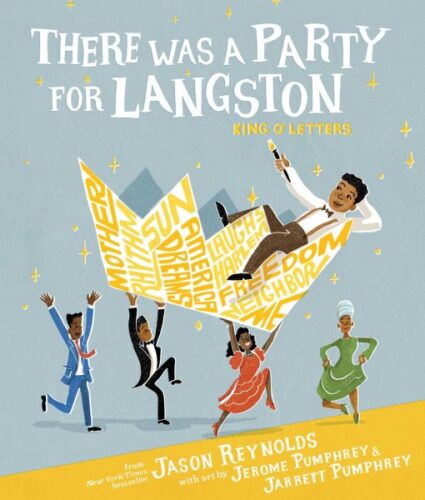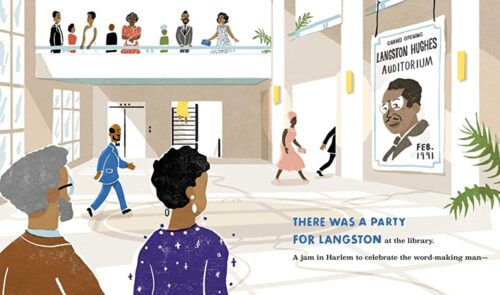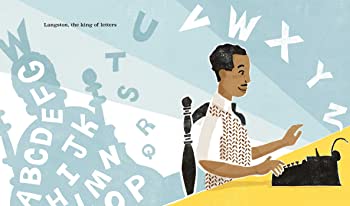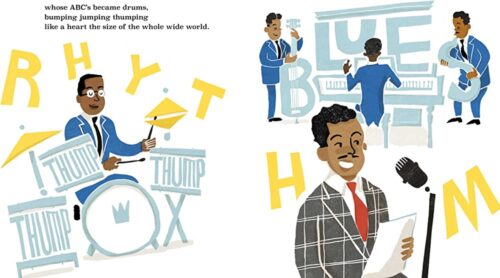Review of the Day: There Was a Party for Langston, King of Letters by Jason Reynolds, ill. Jerome and Jarrett Pumphrey

There Was a Party for Langston: King of Letters
By Jason Reynolds
Illustrated by Jerome and Jarrett Pumphrey
Atheneum/Caitlyn Dlouhy Books (an imprint of Simon & Schuster)
$18.99
ISBN: 9781534439443
Ages 4-7
On shelves October 3rd
In 1991 the New York Times photographer Chester Higgins Jr. went to a party. A bash. A celebration. The kind of party they’d talk about for decades to come. The New York Public Library’s Schomburg Center for Research in Black Culture was celebrating the opening of their brand new Langston Hughes Auditorium and they were doing it with a star studded celebration full of famous writers. *CLICK* Higgins got a shot of Maya Angelou dancing with Amiri Baraka as a crowd circled them. Beneath their feet, the scattered ashes of Langston Hughes himself. There have been lesser images that have inspired plays, novels, even films. For author Jason Reynolds, it would become a format he’s never published before: Nonfiction Picture Book. And why not? Having conquered middle grade and young adult fiction, picture books were perhaps a logical next step for him. One can imagine that it would have been near impossible for him to resist too. Literary heroes dancing on the ashes of their own literary heroes? A great book for children is one where you read it and find yourself wondering, “How is it possible that this book wasn’t made before now?!?” It’s the feeling you get when you turn that last page and find yourself saying aloud, “There you are. What took you so long to get here?” Even better if precisely the right author is paired with precisely the right illustrator along the way. In There Was a Party for Langston you aren’t merely bathed in that feeling. You are suffused.
“There was a party for Langston at the library.” And who better to receive such praise? Langton Hughes, “the king of letters”, who could write stories and rhymes. This was a party for “the word-making boy, who had grown up to be a word-making man, and had now become the word-making king.” He’d influenced two of the people at the party in particular. Folks like Maya Angelou, who “could make the word WOMAN seem like the word MOUNTAIN.” Folks like Amiri Baraka, who “Could make the word BLACK echo into the future and way back into the past …” He wrote these two into this world and they danced together, over him, over his words, for him. “Where the books were listening, just like you.”
ADVERTISEMENT
ADVERTISEMENT

The subtitle of this book is “King of Letters”. Now this is not the first Langston Hughes picture book I’ve ever seen. It’s just the only one I’ll ever be able to remember. Jason Reynolds is one of our most preeminent authors for kids and that’s a testament to the ways in which he’s capable of stringing words together. So to make this book work he had to do two things at once. First, he had to figure out its form. Second, he had to fill it with the right words in the right places so as to invoke the right feelings. In terms of form, Jason turns back to that photograph. That’s his climax right there. He just has to get the reader to that point. That means laying a bit of groundwork. You’ve gotta set the scene first and foremost (the library party), then explain who the party is for (Langston) and his story. Always returning back to the party, Jason zigs zags in an out of the scene, showing the writer’s influence on everything from Martin Luther King Jr. to Harlem to the flames of book banners’ fires (though, to be fair, I think it may be the Pumphreys who are doing a lot of the historical heavy-lifting in these scenes). Back at the party he zeroes in on Maya, then Amiri, then the two of them, at last, dancing. THEN back to Langston again! That’s a surprise but it works. With a final back-up into that library party at long last, it’s this constant push and pull, reminding you of the central story while also pulling in history from every possible corner, using the characters he has at hand. It’s adept is what it is. And in a mere 56 pages at that.
Then there’s that language I alluded to. You know, I always feel badly when I see a contemporary illustrator work on a book about a professional artist. I see it as a sort of a no-win situation. If the artist completely replicates the work of the artist then it’ll be judged for its accuracy. If they don’t, even if that’s on purpose, same. I never seem to feel the same way when it comes to writers writing about writers, though. Maybe I should. The principle remains, but I only ever remember that when I read great writing. In this book Jason Reynolds is playing with his words, partly in homage but mostly because it’s what he himself does best. The party at the center is a “fancy-foot, get-down, all-out bash.” “Don’t nobody dance like a word maker.” And, of course, my favorite part of the entire book is when Amiri is described as a man who at the party, “Came to offer his rickety radio heart to Langston…” If I’ve failed to convey this properly, let me just say it out loud: In writing There Was a Party for Langston, Jason Reynolds is clearly having the time of his life.
In an interview about the Schomburg Library party, Jason Reynolds once said to Publishers Weekly, “We think of libraries as sacred spaces. For me at least, I don’t know what’s more sacred than people paying tribute to one of the greatest word-makers of our time, but also people enjoying themselves. Kids having fun is sacred. They should be able to do that at the playground or in the library.” It’s no coincidence that “Fun” is precisely what sets There Was a Party for Langston apart too. Inspired by a moment of pure literary joy, don’t assume for a second that the tone of this book was a given. For decades upon decades the bulk of historical or nonfiction books for kids about our African-American past have been overwhelmingly bleak. There’s a reason there’s been such a huge push for #Blackjoy in titles for kids. Things have been getting a little better, but a lot of time “joy” can translate into blandly positive aphorisms. Our kids? They deserve better. They deserve joy with bite. Books that have the smarts and the fun mixed in together. So what There Was a Party for Langston does is manage to tell a fun story (party in the library – woot!!) while also flashing back to three different histories (Langston, Maya, Amiri). There are allusions to history and pain but such allusions are not the focus of this book. This is a book about a friggin’ party in a friggin’ library and for that to work you need art that exemplifies that enthusiasm.

I’ve been saying for years that when paired with the right author, the Pumphreys would launch their careers stratosphere-wise. Until now they’ve only ever done their own books, which is fine and all but some of the greatest picture books in the world only happened when the right combination of wordsmith and paint-wielder were brought together. Alone, the Pumphreys books are sweet and kind. Sometimes they involve animals that die in unfortunate ways, but even those books are more “nice” than anything else. These are artists that require a bit of a spark to ignite. Reynolds, similarly, has struggled in the past with writing for younger audiences. While he thrills when it comes to middle grade and teen readers, his Stuntboy graphic novels were an odd aberration in an otherwise illustrious career. Those books didn’t seem to know how to speak to younger readers, which is so strange to say about the guy who brought us Ghost. Stuntboy, ultimately, talked down to its child audience. There Was a Party for Langston, in contrast, not only respects its younger young readers but gives them something bigger and wider and deeper to consider. And the Pumphreys, whose talents have just been waiting in the wings for the right project, suddenly find themselves handed a challenge worthy of their skills. Not simply to bring the words of Jason Reynolds to life but to encompass what he, Reynolds, and a host of other Black writers of American literature have brought to the literary scene/sphere/canon. Daunting and necessary.
ADVERTISEMENT
ADVERTISEMENT
About the art Jason Reynolds (I’m just going to keep quoting him here since he has a way of writing my reviews for me) says, “You write enough to lob the ball so that the illustrator has just enough space to do their dance.” Mixed-metaphors aside, it’s such a relief for him to say this. Right off the bat, Reynolds understands the role of the author. In a truly great picture book pairing, the author and artist work together in tandem. I could say something about jazz riffs here but that feels a bit too obvious. Many picture books have a magnificent text with so-so pictures or amazing art with blah text (see: celebrity authors). Even great writers working with great illustrators have to create magic with one another, a fact made all the more difficult when you realize that most authors are kept at arm’s length from their illustrators by their editors. The reasons for this are obvious. The last thing an artist needs is some nitpicky author peering over their shoulder remarking things like, “I never thought her teeth would look like that.” So how to collaborate? You do what Reynolds says here. First, you trust the artist. Then, you give them places to play. You leave ideas wide open. That way, when Jason describes Langston as, “The man who wrote Maya and Amiri into the world,” he’s given the Pumphreys the space to turn each writer’s body into the very letters of their own names.

Look at the publication page and the art of this book is described as having been, “created with handmade stamps and edited digitally.” That’s a whole lotta stamps but it’s a technique the Pumphreys have perfected over the years. No one’s art looks like their art. It’s utterly unique in this sense. When you see a Pumphrey book, you know that they’re the only ones that could have made it. But until now I’d never had such a clear sense of how adept they could be at design and typography. Reynolds has indeed given them an immense amount of space, allowing them to play with the visual nature of language in ways they’ve never been able to before. Here’s where I got a bit confused about how much collaboration took place in this book. Whose idea was it to take the words of Langston Hughes and turn them into Martin Luther King Jr.’s podium or to take the words “Freedom stands up and laughs in their faces” and turn them into a magnificent, “HA”? I think it had to be the Pumphreys who put the great authors of the past and had them peer out from their books at the partygoers, allowing the book to show off everyone from W.E.B. Dubois to Octavia Butler (and extra points for the inclusion of Ashley Bryan, by the way). What I really loved as I read, though, was that just as Jason Reynolds is delighting in language and the characters are whooping it up at the party, so too are the Pumphreys just having the time of their lives playing with working words and letters into spaces and shapes in innovative, enjoyable ways. Theirs is a visual poetry perfectly in sync with the text. THAT is what we are talking about when we talk about the great picture books. This linking. This fun.
Langston Hughes wrote for kids, you know. During the era of McCarthyism when he was blacklisted, he wrote quite a few books for kids (the story of blacklisted children’s book creators is worth a book of its own, you know). I found a fair number of those books back when I worked for New York Public Library in the Schomburg’s library collection. Apropos. Considering the times in which he lived, I don’t know if Langston would have written for kids had he not been put into that position. I do know that for all his talents, he never had a chance to create a book like There Was a Party for Langston himself. Interestingly, it’s a nonfiction book, though there seems to be some confusion about that. How can a book that’s true be this enjoyable? But bereft of fake dialogue, based on a true incident in history, and full only of facts and true opinions, this is as real as it gets, folks. With a single photograph you get a truly great picture book pairing and the start of a beautiful collaboration. Because if he could have seen it, even Langston would concede that there’s no way to improve upon this. To life! To joy! To books! And more like this, please.
On shelves October 3rd
Source: Borrowed from bookstore friend.
Misc: And this just in! The news article reads A forgotten book by Langston Hughes and Elmer W. Brown emerges in Cleveland. See, I told you he wrote for kids!
Filed under: Best Books, Best Books of 2023, Reviews, Reviews 2023
About Betsy Bird
Betsy Bird is currently the Collection Development Manager of the Evanston Public Library system and a former Materials Specialist for New York Public Library. She has served on Newbery, written for Horn Book, and has done other lovely little things that she'd love to tell you about but that she's sure you'd find more interesting to hear of in person. Her opinions are her own and do not reflect those of EPL, SLJ, or any of the other acronyms you might be able to name. Follow her on Twitter: @fuseeight.
ADVERTISEMENT
ADVERTISEMENT
SLJ Blog Network
Happy Poem in Your Pocket Day!
More Geronimo Stilton Graphic Novels Coming from Papercutz | News
Parsing Religion in Public Schools
Environmental Mystery for Middle Grade Readers, a guest post by Rae Chalmers
ADVERTISEMENT







